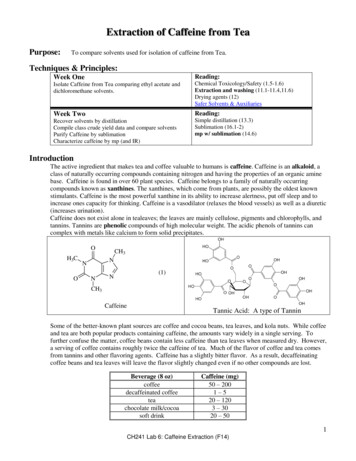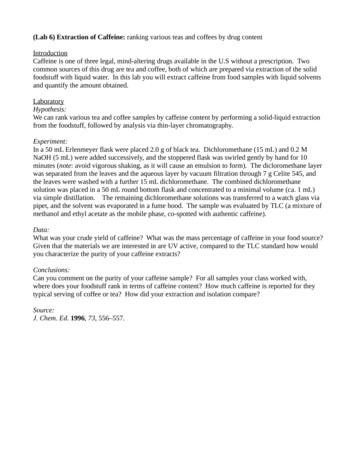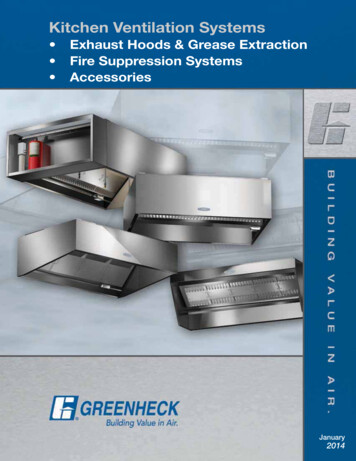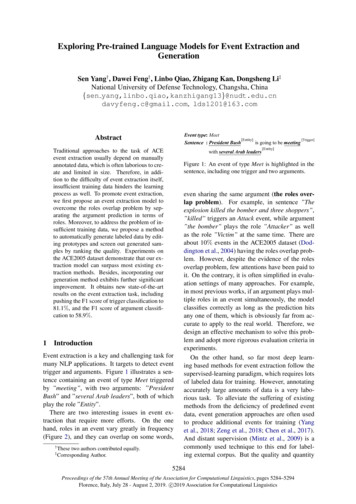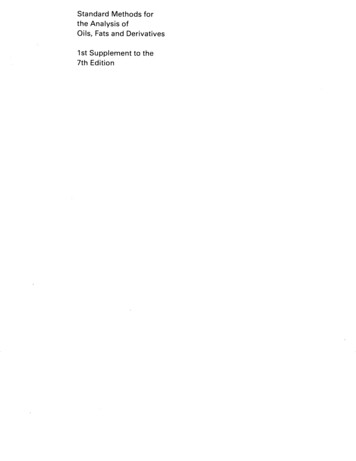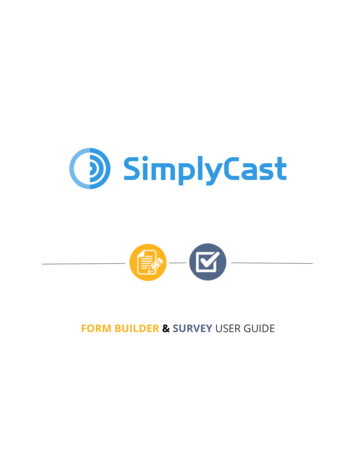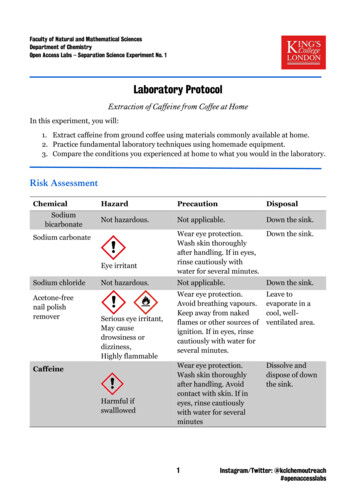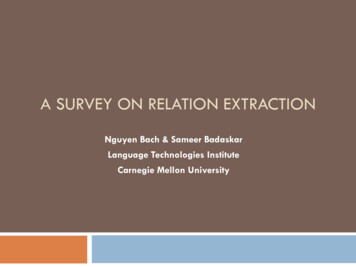
Transcription
A SURVEY ON RELATION EXTRACTIONNguyen Bach & Sameer BadaskarLanguage Technologies InstituteCarnegie Mellon University
Introduction Structuring the information on the webInvolves annotating the unstructured text with Entities Relations between entitiesExtracting semantic relations between entities in text
Entity-Relations Example 1: “Bill Gates works at Microsoft Inc.” Person-Affiliation(Bill Gates, Microsoft Inc) Example 2: Located-In(CMU, Pittsburgh) Higher order relations Protein-Organism-LocationEntity tuple: entities are bound in a relation r e1 , e2 ,., en
Applications Question Answering: Ravichandran & Hovy (2002) Extracting entities and relational patterns for answeringfactoid questions (Example: “When was Gandhi born ?”amounts to looking for Born-In(Gandhi, ?) in the relationaldatabase)Mining bio-medical textsProtein binding relations useful for drug discovery Detection of cancerous genes (“Gene X with mutation Yleads to malignancy Z”)
Evaluation Datasets–– Supervised Approaches–– Automatic Content Extraction mMessage Understanding Conference (MUC-7)http://www.ldc.upenn.eduRelation extraction as a classification task.Precision, Recall and F1Semi-supervised Approaches––Bootstrapping based approaches result in the discovery of largenumber of patterns and relations.Approximate value of precision computed by drawing a randomsample and manually checking for actual relations
Outline Supervised approaches Featurebased Kernel based Concerns Semi-supervised approaches Bootstrapping DIPRE, Snowball, KnowItAll, TextRunnerHigher-order relation extraction
Supervised Approaches (1) Formulate the problem as a classification problem(in a discriminative framework)Given a set of ve and –ve training examples Sentence : S w1w2 .e1.wi .e2 .wn 1wn 1 If e1 and e2 are related by Rf R (T ( S )) 1 Otherwise
Supervised Approaches (2) f R (.)can be a discriminative classifierSVM, Voted Perceptron, Log-linear model Can also be a multiclass classifier! T (S ) can be A set of features extracted from the sentence A structured representation of the sentence (labeledsequence, parse trees)
Supervised Approaches (3) Features Definethe feature set Similarity metrics like cosine distance can be used Structured Representations Needto define the similarity metric (Kernel) Kernel similarity is integral to classifiers like SVMs.
Supervised Approaches (4)FeatureExtractionSentenceTextual Analysis(POS, Parse trees) We’ll come back to K(x,y) a bit laterOR f1 , f 2 ,., f n ClassifierK(x,y)
Features Khambhatla (2004), Zhou et. al. (2005)Given a sentence1.2.Perform Textual Analysis (POS, Parsing, NER)ExtractWords between and including entities Types of entities (person, location, etc) Number of entities between the two entities, whether both entitiesbelong to same chunk # words separating the two entities Path between the two entities in a parse tree
Features Textual Analysis involves POS tagging, dependencyparsing etc.What forms a good set of features ?Choice of features guided by intuition andexperiments.Alternative is to use the structural representations anddefine an appropriate similarity metric for theclassifier!
Kernels Homework #5We were almostthere!!!Kernel K(x,y) defines similarity between objects xand y implicitly in a higher dimensional space(x,y) can be Strings: similarity number of common substrings (orsubsequences) between x and y Example: sim(cat, cant) sim(cat, contact) Excellent introduction to string kernels in Lodhi et. al.(2002) Extend string kernels to word sequences and parsetrees for relation extraction
Kernels (Word Subsequences) Word context around entities can be indicator of a relation Bunescu & Mooney (2005a)e1Left contextK(.,.)Left context* e1 *e2Middle contextK(.,.)Middle context* Labeled ve or –veexampleRight contextK(.,.) Right context*Each word is augmented with its POS, Generalized POS, chunktag (NP, VP, etc), entity type (Person, Organization, none)SimilarityTeste *example2
Kernels (Trees)PAB1. Match attributesof parent nodesPCLabeled ve or–ve exampleDABED2. If parent nodesmatch, add 1 tosimilarity score elsereturn score of 03. Compare childsubsequences andcontinue recursivelyTest example Similarity computed by counting the number of common subtrees Attributes (?), Complexity (polynomial)
Kernels (Trees) Tree kernels differ over types of trees used and attributes of nodesZelenko et. al. (2003) Use shallow parse trees. Each node contains Tasks: organization-location, person-affiliation detectionTree kernel with SVM improves over feature based SVM for both tasks (F1 7% and 3%respectively)Culotta & Sorensen (2004) Use dependency trees. Node attributes are Entity-Role (Person, Organization, Location, None)Text it subsumesChunk tag (NP, VP etc)Word, POS, Generalized POS, Chunk tag, Entity type, Entity-level, Relation argumentThese tree kernels are rigid – attributes of nodes must match exactly!
Kernels Bunescu & Mooney (2005b)Sufficient to use only the shortest path between entities ina dependency tree. Each word in shortest path augmented with POS,Generalized POS, Entity type etc Structure of the dependency path is also encoded Performs the best among all kernels
Kernels Vs FeaturesFeature set DefinitionComputationalComplexityFeature basedMethodsRequired to define a featureset to be extracted aftertextual analysis. Good featuresarrived at by experimentationRelatively lowerKernel MethodsNo need to define a featureset. Similarity computed over amuch larger feature spaceimplicitly.Relatively higher
Supervised Approaches (Concerns) Perform well but difficult to extend to new relationtypes for want of labeled dataDifficult to extend to higher order relationsTextual analysis like POS tagging, shallow parsing,dependency parsing is a pre-requisite. This stage isprone to errors.
Semi-supervised Approaches
So far Formulate relation extraction as a supervisedclassification task.Focused on feature-based and kernel methodsWe now focus on relation extraction with semisupervised wItAll & TextRunnerComparison
Rationales in Relation Extraction EBay was originally Pierre Omidyar.Founder (Pierre Omidyar, EBay)Ernest Hemingway was born in Oak Park-Illinois. founded byBorn in (Ernest Hemingway, Oak Park-Illinois)Read a short biography of Charles Dickens the great English literaturenovelist author of Oliver Twist, A Christmas carol. Author of (Charles Dickens, Oliver Twist)Author of (Charles Dickens, A Christmas carol) “Redundancy” : context of entities “Redundancy” is often sufficient to determine relations
DIPRE (Brin, 1998) Relation of interest : (author, book)DIPRE’s algorithm:–Given a small seed set of (author, book) pairs1.Use the seed examples to label some data.2.Induces patterns from the labeled data.3.Apply the patterns to unlabeled data to get new set of(author,book) pairs, and add to the seed set.4.Return to step 1, and iterate until convergence criteria isreached
Seed: (Arthur Conan Doyle, TheAdventures of Sherlock Holmes).A Web crawler finds all documentscontain the pair.
Read The Adventures of Sherlock Holmes by Arthur Conan Doyleonline or in you email [0, Arthur Conan Doyle, The Adventures of Sherlock Holmes,Read, online or, by].Extract tuple:A tuple of 6 elements: [order, author, book, prefix, suffix, middle]prefix and suffix are strings contain the 10 characters occurring to the left/right of the matchmiddle is the string occurring between the author and book.order 1 if the author string occurs before the book string, 0 otherwise
know that Sir Arthur Conan Doyle wrote The Adventures ofSherlock Holmes, in 1892. Extract tuple:[1, Arthur Conan Doyle, The Adventures of Sherlock Holmes,now that Sir, in 1892, wrote].
.When Sir Arthur Conan Doyle wrote the adventures of SherlockHolmes in 1892 he was high.Extract tuple:.[1, Arthur Conan Doyle, The Adventures of Sherlock Holmes,When Sir, in 1892 he, wrote]
Extracted list of tuples:[0, Arthur Conan Doyle, The Adventures of Sherlock Holmes, Read, online or, by][1, Arthur Conan Doyle, The Adventures of Sherlock Holmes, now that Sir, in 1892, wrote][1, Arthur Conan Doyle, The Adventures of Sherlock Holmes, When Sir, in 1892 he, wrote] Group tuples by matching order and middle and induce patternsInduce patterns from group of tuples:[longest-common-suffix of prefix strings, author, middle, book, longest-common-prefix of suffix strings]Pattern:[Sir, Arthur Conan Doyle, wrote, The Adventures of Sherlock Holmes, in 1892]Pattern with wild card expression:[Sir, .*?, wrote, .*?, in 1892]
Use the wild card patterns [Sir, .*?, wrote, .*?, in 1892]search the Web to find more documents Sir Arthur Conan Doyle wrote Speckled Band in 1892, that isaround 62 years apart which would make the stories Extract new relations:(Arthur Conan Doyle, Speckled Band)Repeat the algorithm with the new relation.
Snowball (Agichtein & Gravano, 2000) Architecture: similar to DIPRE; relation INGINTELLOCATIONREDMONDARMONKSEATTLESANTA CLARAInitial SeedOccurrences of Seed TuplesGenerate New SeedRelationTag EntitiesGenerate Extraction PatternsAgichtein, 2000
Snowball (Agichtein & Gravano, 2000) Tuples: [author, book, prefix, suffix, middle]– Group tuples by a similarity function– represented in feature vectors, each token is associatedwith a term weightHigher similarity: tuples share common termsInduce patterns:––A pattern is a centroid vector tuple of a groupAssign pattern confidence score
KnowItAll (Etzioni et al. 2005) An autonomous, domain-independent system thatextracts facts from the Web.The primary focus of the system is on extractingentities (unary predicates).The input to KnowItAll is a set of entity classes to beextracted, such as “city”, “scientist”, “movie”, etc.,and the output is a list of entities extracted from theWeb.
KnowItAll (Etzioni et al. 2005) Uses only the generic hand written patterns. The patterns are basedon a general Noun Phrase (NP) chunker.Example patterns NP1 “such as” NPList2 including cities such as Birmingham, Montgomery, Mobile, Huntsville publisher of books such as Gilgamesh, Big Tree, the Last Little Cat NP1 “and other” NP2NP1 “including” NPList2NP1 “is a” NP2NP1 “is the” NP2 “of” NP3“the” NP1 “of” NP2 “is” NP3
TextRunner (Banko et al. 2007) DIPRE, Snowball, KnowItAll: relation types arepredefined. TextRunner discovers relationsautomaticallyExtract Triple representing binary relation (Arg1,Relation, Arg2) from sentence.EBay was originally founded by Pierre Omidyar.EBay was originally founded by Pierre Omidyar.(Ebay, Founded by, Pierre Omidyar)
TextRunner (Banko et al. 2007)3 main components1. Self-Supervised Learner: automatically labels /- examples &learns an extractor2. Single-Pass Extractor: single pass over corpus, identifyingrelations in each sentence3. Redundancy-based Assesor: assign a probability to eachretained relations based on a probabilistic model of redundancyin text introduced in based on (Downey et al. 2005)Etzioni, 2007
Englishal-takriti had beentransferred together with17 Iraqi ambassadors Constraints11. There exists a dependency chainbetween e1 and e2 that is not longerthan a certain length.2. This chain should contain some wordsof the relation r (usually the main verb)3. The path from e1 to e2 along the syntaxtree doesn’t cross the sentence-likeBoundary (e.g. relative clauses). Thismeans that this path can containS (SINV, ROOT etc) constituents onlyat the common ancestor position.4. Entities do not consist solely ofthe pronoun.5. r should contain at least one VP tag.6. r and e2 should have at least onVP tag as a common akriti-1, had-2 been-3 transferred-4 together-5 with-6, 17-7 iraqi-8 ambassadors-9)POSITIVE(al-takriti-1, had-2 been-3 transferred-4 to-11, baghdad-12)POSITIVE(al-takriti-1, had-2 been-3 transferred-4, the-22 official-23 iraqi-23 newspapers-24)NEGATIVE(al-takriti-1, announced-20 by-21, the-22 official-23 iraqi-23 newspapers-24)NEGATIVE 6FeatureVectorSVM,Naïve Bayes,RIPPER RelationClassifier
Englishking hussein was admittedto the american specialisthospital after he sufferedsweating spells and rise RelationGeneratorSVM,Naïve Bayes,RIPPER FeatureVectorRelationClassifier
ComparisonDIPRESnowballKnowItAllTextRunnerInitial seedYesYesYesNoPredefined relationYesYesYesNoExternal NLP toolsNoYes: NERYes: NPchunkerYes: dependencyparser, NPchunkerRelation ge dependent NoClassifierExact pattern Matching with Naïve rvisedbinary classifierInput parameters2N/A9 4
Higher-order Relation Extraction
Higher-order Relations So far, reviewed methods focus on binary relationsIt is not straightforward to adapt to higher-orderrelation types. (e1, e2, , en): each ei has a type ti Ternary relation: T (people, job, company) “John Smith is the CEO at Inc. Corp” (John Smith, CEO, Inc. Corp)
McDonald et al. 2005 Factoring higher-order relations into a set of binary relations Use a classifier to extract binary relations Create entities graph Reconstruct higher-order relationsby finding maximal cliques
Conclusion Supervised approaches Semi-supervised approaches Feature-based and kernel methodsBootstrappingHigher-order relation extractionApplicationsQuestion-Answering Mining biomedical text Evaluation
THANK YOUFeedback:nbach@cs.cmu.edu& sbadaska@cs.cmu.edu
Available Toolkits Parser Stanford parser: syntax and dependency parser (Java) MST parser: dependency parser (Java) Collins parser: syntax parser (C ) ; Dan Bikel duplicates in Java. Charniak parser: syntax parser (C )English NP chunker OpenNLP: Java GATE: Java Ramshaw&Marcus: JavaNamed Entities Recognizer Stanford NER: Java MinorThird: Java ( from William Cohen’s group at CMU) OpenNLP GATETree Kernels in SVM-light
References Abney, S. (2004). Understanding the yarowsky algorithm. Comput. Linguist. (pp. 365–395). Cambridge, MA, USA: MIT Press.Agichtein, E., & Gravano, L. (2000). Snowball: Extracting relations from large plain-text collections. Proceedings of the Fifth ACM International Conference on DigitalLibraries.Banko, M., Cafarella, M. J., Soderland, S., Broadhead, M., & Etzioni, O. (2007). Open information extraction from the web. IJCAI ’07: Proceedings of the 20thInternational Joint Conference on Artificial Intelligence. Hyderabad, India.Bikel, D. M., Schwartz, R. L., & Weischedel, R. M. (1999). An algorithm that learns what’s in a name. Machine Learning, 34, 211–231.Blum, A., & Mitchell, T. (1998). Combining labeled and unlabeled data with co-training. COLT: Proceedings of the Workshop on Computational Learning Theory, MorganKaufmann Publishers (pp. 92–100).Brin, S. (1998). Extracting patterns and relations from the world wide web. WebDB Workshop at 6th International Conference on Extending Database Technology, EDBT’98.Bunescu, R. C., & Mooney, R. J. (2005a). A shortest path dependency kernel for relation extraction. HLT ’05: Proceedings of the conference on Human LanguageTechnology and Empirical Methods in Natural Language Processing (pp. 724–731). Vancouver, British Columbia, Canada: Association for Computational Linguistics.Bunescu, R. C., & Mooney, R. J. (2005b). Subsequence kernels for relation extraction. Neural Information Processing Systems, NIPS 2005, Vancouver, British Columbia,Canada.Culotta, A., McCallum, A., & Betz, J. (2006). Integrating probabilistic extraction models and data mining to discover relations and patterns in text. Proceedings of themain conference on Human Language Technology Conference of the North American Chapter of the Association of Computational Linguistics (pp. 296–303). New York,New York: Association for Computational Linguistics.Culotta, A., & Sorensen, J. (2004). Dependency tree kernels for relation extraction. ACL ’04: Proceedings of the 42nd Annual Meeting on Association for ComputationalLinguistics (p. 423). Morristown, NJ, USA: Association for Computational Linguistics.Downey, D., Etzioni, O., & Soderland, S. (2005). A probabilistic model of redundancy in information extraction. IJCAI (pp. 1034–1041).Etzioni, O., Cafarella, M., Downey, D., Popescu, A. M., Shaked, T., Soderland, S., Weld, D. S., & Yates, A. (2005). Unsupervised Named-Entity Extraction from theWeb:An Experimental Study. Artificial Intelligence (pp. 191–134).Finkel, J. R., Grenager, T., & Manning, C. (2005). Incorporating non-local information into information extraction systems by gibbs sampling. ACL ’05: Proceedings ofthe 43rd Annual Meeting on Association for Computational Linguistics (pp. 363–370). Morristown, NJ, USA: Association for Computational Linguistics.
References Grishman, R., & Sundheim, B. (1996). Message understanding conference - 6: A brief history. Proceedings of the 16th conference on Computational Linguistics (pp. 466–471).GuoDong, Z., Jian, S., Jie, Z., & Min, Z. (2002). Exploring various knowledge in relation extraction. Proceedings of the 43rd Annual Meeting on Association forComputational Linguistics (pp. 419–444).Kambhatla, N. (2004). Combining lexical, syntactic, and semantic features with maximum entropy models for extracting relations. Proceedings of the ACL 2004.Liu, Y., Shi, Z., & Sarkar, A. (2007). Exploiting rich syntactic information for relationship extraction from biomedical articles. Human Language Technologies 2007: TheConference of the North American Chapter of the Association for Computational Linguistics; Companion Volume, Short Papers (pp. 97–100). Rochester, New York:Association for Computational Linguistics. Lodhi, H., Saunders, C., Shawe-Taylor, J., & Cristianini, N. (2002). Text classification using string kernels. Journal of Machine Learning Research (pp. 419–444). McDonald, R. (2004). Extracting relations from unstructured text. UPenn CIS Technical Report. McDonald, R., Pereira, F., Kulick, S., Winters, S., Jin, Y., & White, P. (2005). Simple algorithms for complex relation extraction with applications to biomedical ie. ACL’05: Proceedings of the 43rd Annual Meeting on Association for Computational Linguistics (pp. 491–498). Ann Arbor, Michigan.Nguyen, D. P., Matsuo, Y., & Ishizuka, M. (2007). Subtree mining for relation extraction from Wikipedia. Human Language Technologies 2007: The Conference of theNorth American Chapter of the Association for Computational Linguistics; Companion Volume, Short Papers (pp. 125– 128). Rochester, New York: Association forComputational Linguistics. NIST (2007). The ace 2007 (ace07) evaluation plan. 07-evalplan.v1.3a.pdf. PubMed (2007). Medline. PubMed Home, http://www.ncbi.nlm.nih.gov/sites/entrez. Ravichandran, D., & Hovy, E. (2002). Learning surface text patterns for a question answering system. In proceedings of the ACL Conference. Yarowsky, D. (1995). Unsupervised word sense disambiguation rivaling supervised methods. Proceedings of the 33rd conference on Association for ComputationalLinguistics (pp. 189–196). NJ, USA.Zelenko, D., Aone, C., & Richardella, A. (2003). Kernel methods for relation extraction. Journal of Machine Learning Research.Zhao, S., & Grishman, R. (2005). Extracting relations with integrated information using kernel methods. Proceedings of the 43rd Annual Meeting on Association forComputational Linguistics (pp. 419–426).
Read The Adventures of Sherlock Holmes by Arthur Conan Doyle online or in you email Extract tuple: [0, Arthur Conan Doyle, The Adventures of Sherlock Holmes, Read, online or, by] A tuple of 6 elements: [order, author, book, prefix, suffix, middle] order 1 if the author string occurs before the book string, 0 otherwise

